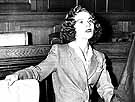
|
|
|

|

|

|

|
|
Click on an image to see a larger, more detailed picture.
|
|
|
|
|
| 1943: Death and Resistance |

|
pg. 421 |

|
|
|
|
| |
 Blonde Poison
Blonde Poison
Still alive today, Stella Goldschlag was a German Jew who had Aryan looks. In her youth, the shapely blue-eyed blonde was a compulsive liar and renegade who desperately hated her Jewishness. Threatened, along with her parents, with deportation to the East and tortured by the Gestapo, Goldschlag was among a small number of Jews who collaborated with the Nazis and worked for the Gestapo. She received money, good food, and a temporary reprieve from deportation for her parents. Using sex, her incredible memory, and her ruthlessness, Goldschlag's job was to root out the other so-called "U-boats"--Jews living underground in Berlin during the war--and to help the Gestapo arrest them. Those Jews would be sent off to extermination camps. On one weekend alone, Goldschlag helped the Gestapo catch 62 Jews. She was indeed the "Blonde Poison," seducing Jews to their deaths.
Photo: Ullstein Bilderdienst
|
 German Field Marshal Friedrich Paulus (left), accompanied by two staff officers, walks toward Red Army headquarters to sign the formal surrender of the Sixth Army at Stalingrad, Russia. Paulus had begged Hitler to allow a retreat before it became too late, but the Führer refused to give up, leaving the exhausted and starving army surrounded by Soviet forces. "Fortress Stalingrad," as Hitler called the troops, could not withstand the fierce winter and the lack of supplies and reinforcements. Against orders and in the hopes of saving his remaining men, Paulus surrendered on February 3. While he and his senior staff survived, most of his men did not.
German Field Marshal Friedrich Paulus (left), accompanied by two staff officers, walks toward Red Army headquarters to sign the formal surrender of the Sixth Army at Stalingrad, Russia. Paulus had begged Hitler to allow a retreat before it became too late, but the Führer refused to give up, leaving the exhausted and starving army surrounded by Soviet forces. "Fortress Stalingrad," as Hitler called the troops, could not withstand the fierce winter and the lack of supplies and reinforcements. Against orders and in the hopes of saving his remaining men, Paulus surrendered on February 3. While he and his senior staff survived, most of his men did not.
Photo: Bilderdienst SYddeutscher Verlag
|
 At the edge of a forest in Germany, Schutzpolizei (Protective Police) post a notice--perhaps a declaration of confiscation--on a Gypsy wagon. Gypsies were special targets of the Nazis, who saw them as a potential danger to the presumed purity of the "Aryan race." The essential mismatch of the Nazi/Gypsy relationship is clear in this tableau, as the husky, warmly dressed policemen, carried to the remote site in their modern automobile, confront the apprehensive Gypsy at his home, a wheeled relic of an earlier era.
At the edge of a forest in Germany, Schutzpolizei (Protective Police) post a notice--perhaps a declaration of confiscation--on a Gypsy wagon. Gypsies were special targets of the Nazis, who saw them as a potential danger to the presumed purity of the "Aryan race." The essential mismatch of the Nazi/Gypsy relationship is clear in this tableau, as the husky, warmly dressed policemen, carried to the remote site in their modern automobile, confront the apprehensive Gypsy at his home, a wheeled relic of an earlier era.
Photo: SYddeutscher Verlag Bilderdienst
|
|

|

|

|

|
 January 27, 1943: The Eighth USAAF (United States Army Air Force) mounts the first all-American air raid on Germany, at Wilhelmshaven.
January 27, 1943: The Eighth USAAF (United States Army Air Force) mounts the first all-American air raid on Germany, at Wilhelmshaven.
|
 January 28-31, 1943: Ten thousand Jews from Pruzhany, Belorussia, are deported to Auschwitz.
January 28-31, 1943: Ten thousand Jews from Pruzhany, Belorussia, are deported to Auschwitz.
|
 January 29, 1943: Germans execute 15 Poles at the village of Wierzbica for aiding three Jews. One of the victims is a two-year-old girl.
January 29, 1943: Germans execute 15 Poles at the village of Wierzbica for aiding three Jews. One of the victims is a two-year-old girl.
|
 January 30, 1943: Ernst Kaltenbrunner is named by Hitler to succeed the late Reinhard Heydrich as chief of Reichssicherheits- hauptamt (Reich Security Main Office).
January 30, 1943: Ernst Kaltenbrunner is named by Hitler to succeed the late Reinhard Heydrich as chief of Reichssicherheits- hauptamt (Reich Security Main Office).
|
 February 1943: As the month begins, 40,000 Jews are hiding in the forests of the Volhynia region of Poland. Before the year is out, 37,000 will perish from hunger and execution.
February 1943: As the month begins, 40,000 Jews are hiding in the forests of the Volhynia region of Poland. Before the year is out, 37,000 will perish from hunger and execution.
|
 February 1943: At Bialystok, Poland, eight SS men are killed by members of a Zionist youth movement resisting deportation. Members are captured and deported to the Treblinka death camp, where they attack guards and are killed. Their leader is Eliyahu Boraks.
February 1943: At Bialystok, Poland, eight SS men are killed by members of a Zionist youth movement resisting deportation. Members are captured and deported to the Treblinka death camp, where they attack guards and are killed. Their leader is Eliyahu Boraks.
|
|
|
|
|
| 1943: Death and Resistance |

|
pg. 421 |

|
|
The Holocaust Chronicle
© 2009 Publications International, Ltd.
|
|
